| Report on the investigation into Flexitanks carried out by Germanischer Lloyd and commissioned by the GDV This report was compiled by the GDV. |
[German version] |
|
ISO containers were developed on the basis of road trailers in the 1960s. The original purpose of such containers was to transport dry general cargo. Over the course of time, specialized containers were developed, such as refrigerated containers for temperature-controlled cargo and tank containers for liquid cargo. The rigidity of standard containers means that they were, and still are, intended for transporting dry general cargo. The friction between the cargo and the floor of the container was always taken into account when considering the rigidity of such containers when they were designed. 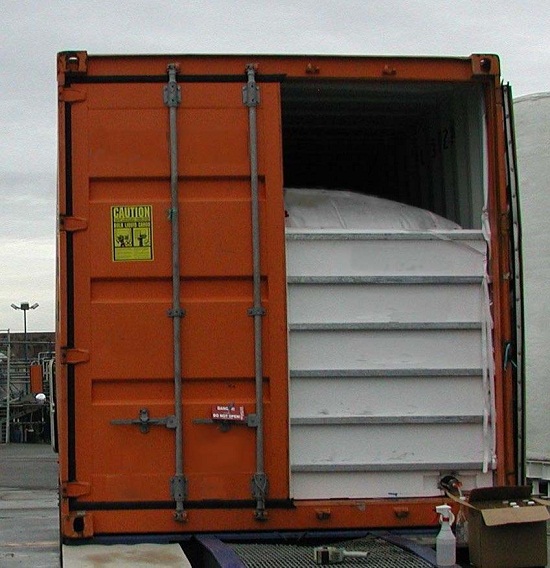 Figure 1. Source: Hapag-Lloyd Professional installation of Flexitank with bar-bulkhead The special containers that were developed included bulk containers that were particularly suited for carrying cargo such as grain. For reasons of hygiene, bulk cargo such as grain is transported in fabric bags large enough to fill the entire container. These fabric bags are attached inside the container before the container is filled. A bulkhead must be installed (see Figure 1) in front of the door of the container to relieve pressure on the door area in order to allow the door to be opened and closed without danger. The concept of bulk liquid transport was derived from the ideas behind the transport of bulk goods in containers. This was achieved by replacing the fabric bag by a "plastic bag" attached inside the container, thus transforming it to a "tank container". The benefits were obvious. The number of empty consignments is minimized and cleaning costs for the tank containers are completely eliminated because the plastic bags used (Flexitanks) are disposable products. As far as dimensioning is concerned, this was initially done intuitively. Because liquids as a rule have no significant internal friction, friction was entirely ignored when dimensioning the Flexitanks. Because containers are constructed in such a way that their end walls are able to withstand 0.4x the payload and their side walls are able to withstand 0.6x the payload, the payload was multiplied by 0.6, presumably because it was assumed the greatest challenge lay in the lateral acceleration forces experience during transportation by sea. This resulted in the Flexitanks being dimensioned with a capacity corresponding to a weight of something between 16 and 17 tonnes. Losses only arose if a valve or the Flexitank itself leaked or if the "tank" ruptured during a braking maneuver on the road or during switching operations with rail transport. By and large, those Flexitanks that were in use (which were relatively few) did not result in a noticeable number of claims. 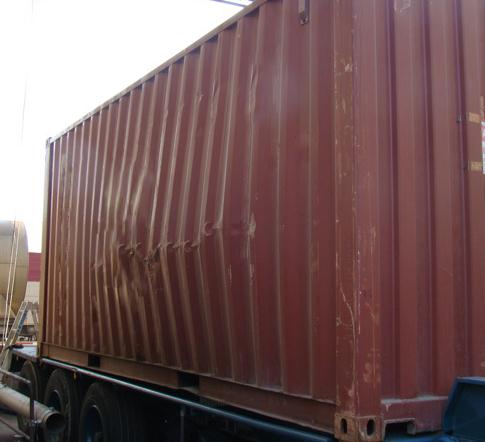 Figure 2. Source: Rainer Kexel INCASE AG When it became clear that transport operations using Flexitanks were possible without significant loss, the physical boundaries were pushed to their limits, and finally beyond. The volume of the Flexitanks, and hence their weight, was increased. To start with, the increases were moderate, up to 20 t, but subsequent increases up to 28 t or 28,000 liters were excessive. If the tank holds 28,000 L, and the liquid it is carrying has a specific gravity of 1.1 t/m³, the weight of the load to be carried by the container is 30.8 t. This results in a gross weight of almost 35 t, and it was not long before the consequences of this began to be felt. Whenever the weather and the stability of the vessel during a sea voyage caused the acceleration forces to rise, an increasing number of the containers themselves were observed to be damaged. This damage ranged from "minor" deformation and buckling right up to structural damage resulting in the container and its cargo being written off. However unfortunate the loss of the cargo and the write-off of a container may be, the biggest problem is those containers that have suffered structural damage and are therefore weakened, but where this damage goes unnoticed. If these containers are taken back into service, the damage they have already sustained could easily cause them to fail in a critical situation. If a container stowed on deck in a stack fails structurally, this can mean that the entire stack is no longer secured properly. On board ships, containers are lashed down diagonally with metal rods (lashing rods) and large turnbuckles. If a container fails structurally, it sags and the lashing rods immediately become loose. From that point on, the entire stack is no longer secured and sways against its neighbors like a metronome in the swell. The load securing measures on the neighboring stacks are only intended for a single stack, and not for a second stack that impacts against them with some considerable kinetic energy. This can result in a domino effect and the loss of an entire bay. Some manufacturers of Flexitanks recommend or even require that the containers used should not be more than three or five years old. They seem to be aware of the fact that the Flexitanks place excessive demands on the containers. It would seem that a recommendation such as this is made in the hope that new containers are more able to withstand the "planned" overloading resulting from the Flexitanks than older containers, but that damage is tacitly accepted. At this point, it should be noted that overloading a container is always a safety risk and must never be tolerated. Since 2000, the number of transportation operations using Flexitanks has been growing continuously, sometimes at double-digit rates, and reports of losses have increased correspondingly. The GDV’s loss prevention committee identified the need for action. In a parallel development, seasonal peaks have been observed in the loss of containers on container ships. One reason for the loss of containers is that the structural integrity of the container itself has been compromised by the cargo it contains. In order to provide a well researched, reliable basis for combating the misuse of standard containers, the GDV’s loss prevention committee decided to commission Germanischer Lloyd to investigate the impact of Flexitanks on the stability of a container during transportation by sea. There were two major thrusts to the investigation:
The dynamic loads resulting from "sloshing" of the liquids are negligible compared with transportation by road or rail. In a tank the size of a container, the natural frequency of a liquid that has a viscosity similar to water is somewhere between 1.5 and 3 seconds. The natural frequency of a rolling ship lies between 8 and 25 seconds. This means that sloshing of the liquid will not in itself apply stress to the structure of the container. 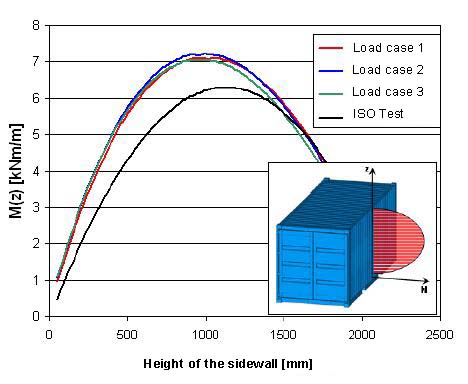 Abbildung 3: Figure 3. Source: Germanischer Lloyd The buckling strength of the sides of the container plays a crucial role in respect of static strength. The ISO trial shows the suitable threshold criterion (see Figure 3) to be used for testing. The buckling strength thresholds for a standard ISO 20′ container were determined using a number of sample calculations (see Load case 1 to 3 in Figure 3). The buckling thresholds were all in the region of 12% above the loads generated by the ISO tests. As a fundamental principle, it is clear that the application of loads to a 20′ ISO container that go beyond the thresholds laid down in the ISO test subjects the container to inappropriate stress and results in a safety risk and unsafe transportation. Impact of the Flexitank on the center of gravity of the cargo in the container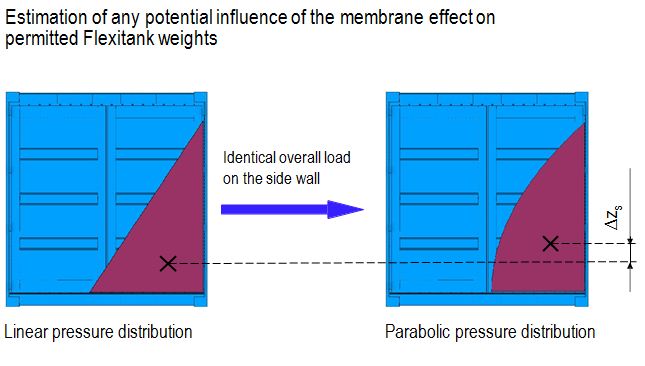 Figure 4. Source: Germanischer Lloyd The Figure 4 shows a comparison of the linear and parabolic pressure distribution of liquids in a standard 20′ container. Linear pressure distribution through liquids applies theoretically if the liquid is able to move freely in a "tank" of the dimensions of a 20′ container. Parabolic pressure distribution is influenced or induced by the pillow-like shape of the Flexitank. Depending on the shape of the Flexitank, the center of gravity of the cargo can be raised by between three and six percent. Maximum permitted weight for FlexitanksThe Figure 5 shows the maximum permitted weight for a Flexitank as a function of the lateral acceleration aq for liquid densities of 1 t/m³. The parabolic pressure distribution causes the center of gravity to be raised. This is then higher against the side wall of the container and thus exerts a greater moment on the side member of the container. 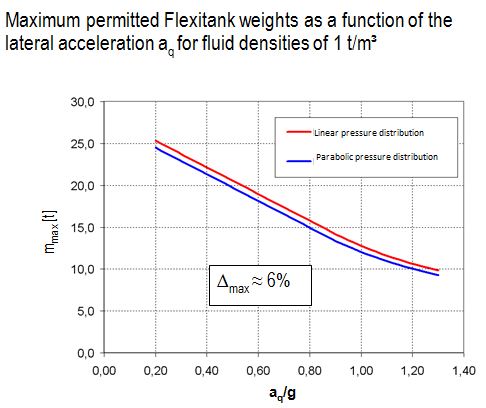 Figure 5. Source: Germanischer Lloyd Plotting the maximum Flexitank weight against lateral acceleration results in curves that are virtually parallel. When a delta of no more than 6% is assumed for the parabolic pressure distribution, the difference between the two curves remains constant at approximately one tonne across the entire length of the curve. If we use these graphs as the basis for investigating the weight of Flexitanks, and if we apply the acceleration values as laid down in the internationally accepted CTU packing guidelines ("Guidelines for the packing of cargo, other than bulk cargo, into or onto cargo transport units (CTUs) applicable to transport operations by all surface and water modes of transport"), the weight of a Flexitank should not exceed 15 t. These guidelines assume a lateral acceleration of 0.8 g during transportation by sea. The acceleration forces generated on an ocean-going vessel depend on a variety of parameters. These parameters are: the stability, the stowage location of the container and the length of the vessel. Stability is understood to be the capacity of the vessel to right itself after heeling. If stability is high, the vessel will right itself quickly, and if the stability is low, it will right itself slowly. The acceleration forces generated will be correspondingly higher or lower. The stability of a vessel depends on the one hand on its shape and, on the other, on the cargo it is carrying and can only be influenced to a limited extent. The stowage position on a vessel is defined when drawing up the stowage plan. Because Flexitank containers are not subject to restrictions on the stowage position during transportation, (because any restriction would result in additional costs), the acceleration forces must be chosen in such a way that the container can be stowed anywhere on the vessel. The length of the vessel is specific to any given vessel, but because scheduled voyages are nowadays organized by alliances of different shipping companies or consignments are booked by shipping agents simply on the basis of the route, availability and tonnage, this is a parameter over which we have little or no influence. The Figure 6 shows the maximum permitted weight of Flexitanks for liquid densities of 0.8 t/m³ for unrestricted transportation on the weather deck in accordance with the stipulations of Germanischer Lloyd. Figure 6 shows two charts. The left-hand chart relates to high stability and correspondingly high lateral acceleration forces, and the right-hand chart relates to low stability and correspondingly low acceleration forces. The stability of a vessel can change several times during the course of a voyage, sometimes by a considerable amount, as a result of the amount, nature and distribution of cargo it is carrying. 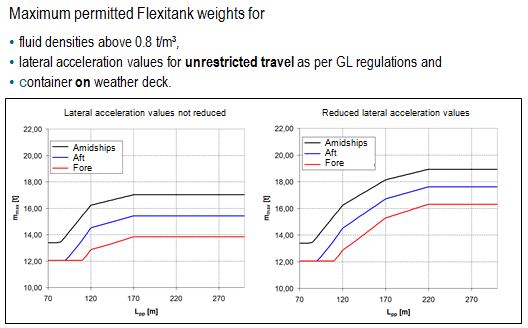 Figure 6. Source: Germanischer Lloyd In Figure 6 the influence of the stowing position, amidships, aft and fore is quite evident. Even the size of a ship also has a tremendous influence on the stability of a ship. The following Figure 7 show the effects of stowage below deck, where a container is stowed closer to the roll axis of the vessel and is subject to lower acceleration forces. The acceleration forces are again shown, taking account of high and low stability, along with the different stowage positions on vessels of different lengths with no transportation restrictions. 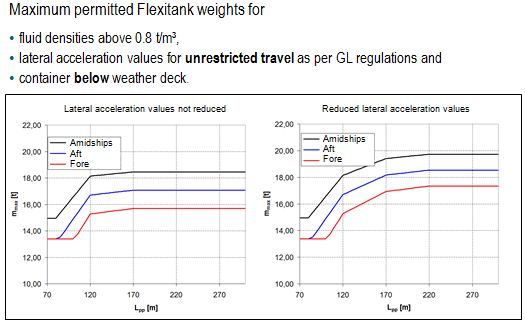 Figure 7. Source: Germanischer Lloyd The region of operationExternal forces are responsible for lateral acceleration forces on a vessel. These external forces are swell, wind waves and the wind itself. The term "unrestricted transportation" occurs frequently in the charts above. Unrestricted transportation means transportation anywhere in the world, including the North Atlantic. The North Atlantic regions 8, 9, 15 and 16, as shown in Figure 8 are highlighted in this chart. If containers are transported on other routes, we are speaking of transportation in restricted areas. 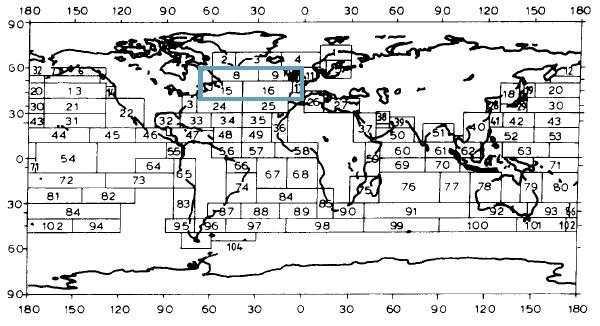 Figure 8. Source: Germanischer Lloyd 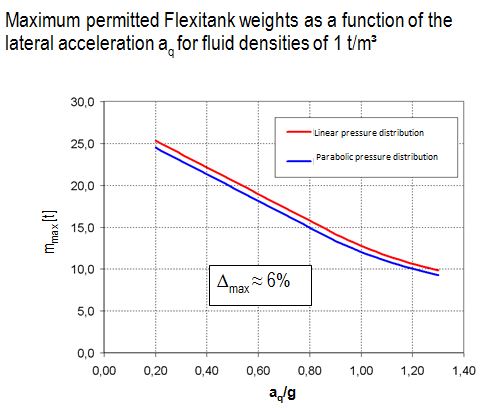 Figure 9. Source: Germanischer Lloyd Germanischer Lloyd has informed us that they are currently investigating lateral acceleration forces on container ships under restricted transportation conditions. Restricted transportation in this context would refer to a voyage from Hamburg to Tokyo, for instance. Without wishing to anticipate the results of the research being carried out by Germanischer Lloyd, we can at this time say that in all probability lateral acceleration forces can be reduced to 0.6 g. If we now consider Figure 9, Flexitanks with a maximum weight of 18 t could be used for restricted transportation. In this case, it is necessary for vessels with a length greater than 170 m to be used. It is, however, highly probable that this will be so on a route such as this. SummaryBased on this investigation by Germanischer Lloyd, maximum sensible weight for safe unrestricted transportation by sea can only be 15 t. According to the above-mentioned investigation, safe restricted transportation of Flexitanks by sea (excluding the ocean regions 8, 9, 15 and 16) is only possible up to a maximum weight of 18 t. These values only apply to vessels of a length greater than 170 m. This investigation has shown that the stability of the vessel and the stowage position, either fore/midships/aft or on deck/below deck significantly affect the lateral acceleration forces during a voyage. It is not possible to have any influence on the stability of a vessel from the outside. This depends on the amount of cargo/ballast the vessel is carrying and on its construction. The stowage position, either on deck/below deck or fore/midships/aft can only be influenced by applying restrictions. Even if the carriers were to accept such restrictions, they would involve additional costs. Our experience suggests that Flexitank users are unlikely to be willing to accept such costs. If Flexitanks weighing more than 15 or 18 t are used and are not transported subject to the restrictions above, the parameters underpinning this investigation (stowage position, length of the vessel, and possibly stability and restricted transportation) should nevertheless be observed. If this is not done, it is not possible to transport Flexitanks safely by sea. If Flexitanks are to be transported on smaller vessels without the restrictions with respect to the stowage position, they can only be safely carried up to the weights shown in figure 9. Closing comments:Up to now, any insights into the usefulness of containers for transporting non-standard cargo have tended to be gleaned from practical experience and trial and error. The associated risk of damage and loss not only of the cargo, but frequently of the container and the risks to life and limb for those involved in handling the cargo make it absolutely necessary that we agree upon planned and safe usage, even in unusual and as yet unknown applications. This investigation into Flexitanks carried out by Germanischer Lloyd and commissioned by the GDV under the auspices of the Marine insurance industry was performed on the basis of objective approaches to serve as a scientific foundation for the benefit of all commercial parties involved. It is absolutely crucial that containers are only used within their physical capabilities. We want to use our insights to initiate a dialog with all those involved in order to come to a consensus on future standards for the safe transportation of Flexitanks in particular. |
Top of page |
